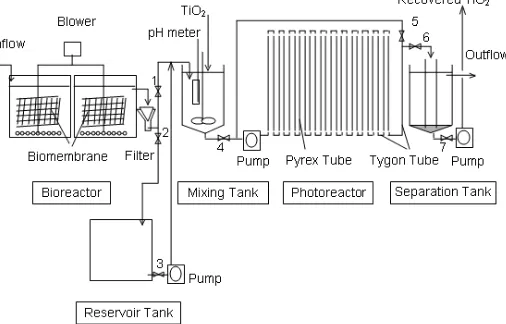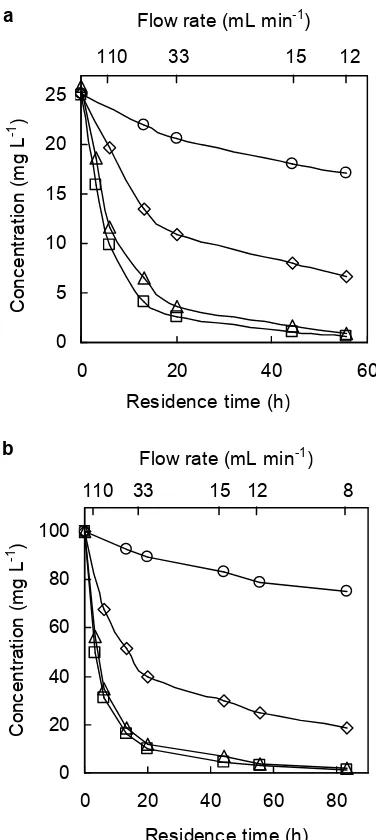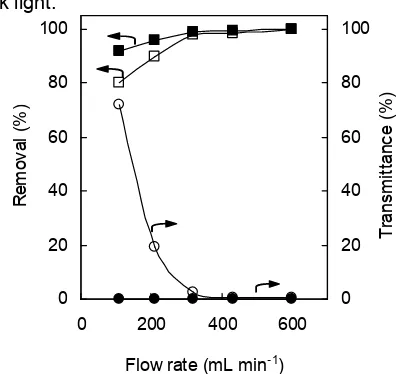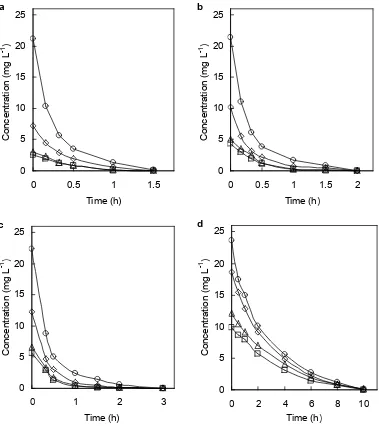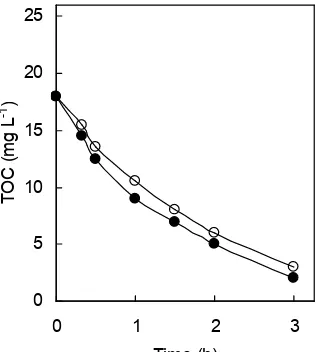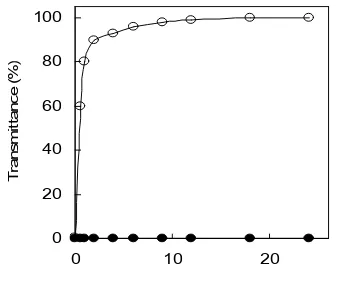* Corresponding author. Tel/Fax : +81-76-4456697 Email address : [email protected]
COMBINED BIOLOGICAL-PHOTOCATALYTIC TREATMENT FOR THE MINERALIZATION
OF A MIXTURE OF CHLOROPHENOLS IN AN ELECTROLYTE-CONTAINING MODEL
WATER AND SPONTANEOUS SEDIMENTATION OF TITANIUM DIOXIDE
Dhanus Suryaman, Kiyoshi Hasegawa*, Shigehiro Kagaya, and Toshiaki Yoshimura
Department of Chemical and Biochemical Engineering, Faculty of Engineering, University of Toyama, 3190 Gofuku, Toyama 930-8555
Received 3 May 2007; Accepted 18 July 2007
ABSTRACT
To shorten the biological treating time and to examine the effect of electrolytes in a model water on the photocatalytic treatment, the combined biological-photocatalytic treatment was evaluated for removal of a mixture (total: 100 mg L-1, each: 25 mg L-1) of 2-chlorophenol (2-CP), 2,4-dichlorophenol (2,4-DCP), 2,4,5-trichlorophenol (2,4,5-TCP), and pentachlorophenol (PCP) in tap water. The mineralization of the four phenols was performed by a flow (biological treatment)-circulative flow (photocatalytic treatment) operation under black light and sunlight irradiations. After a large portion of biodegradable 2-CP and 2,4-DCP, and around half amount of slightly biodegradable 2,4,5-TCP were removed by the biological treatment, the remained three chlorophenols, biorecalcitrant PCP, and biodegradation products were completely removed by the subsequent photocatalytic treatment. The combined treatment significantly shortened the degradation time only the biotreatment. High circulative flow rate (600 mL min-1) enabled for TiO2 particles to completely suspend in a tubular photoreactor and resulted in high removals of chlorophenols and TOC. Sunlight irradiation was successfully used and the saving of the electric energy of black light was possible. Since TiO2 particles in the tap water spontaneously sedimented on standing after the photocatalytic treatment, the combined system can be operated by integrating it with the TiO2 separation.
Keywords: photocatalysis, titanium dioxide, biodegradation, pollutant, wastewater
INTRODUCTION
Chlorophenols are introduced into the environment as a result of several man-made activities, such water disinfection, waste incineration, uncontrolled use of pesticides, herbicides, antiseptics, etc [1]. Because of their numerous origins, they are commonly found in industrial wastewaters, soil, sediment and ground waters [2]. Therefore, it is important to develop effective methods to remove them either to be less harmful intermediates or to complete mineralization.
Among the methods, advanced oxidation processes (AOPs) constitute a promising technology for the treatment of wastewaters containing biorecalcitrant compounds, like chlorophenols which have high toxicity and low biodegradability [3]. Some the following AOPs: H2O2/UV [4], O3/UV, UV/fenton [5], fenton [6], TiO2/UV [7-9], and UV photolysis [10] have been studied for decomposing chlorophenols. Unfortunately, the AOPs can also produce more toxic and/or biorecalcitrant intermediate/products [11].
On the other hand, biological remediation methods under aerobic or anaerobic conditions for decomposing chlorophenols have been also studied [12-14]. However, they are also less versatile as microbial activity is more easily affected by the toxicity. Therefore, alternative methods of combined AOPs and biological treatment have been proposed [15]. In case of the
combined photochemical-biological treatments of chlorophenols using small scale reactors, special cares should be taken in the following fate of photoproducts [10] and a pre-conditioning (removal of H2O2, O3 or TiO2) for subsequent biological treatment. The TiO2 photocatalytic treatment can be more economic when using sunlight irradiation [16].
EXPERIMENTAL SECTION
Materials
All chemicals were of reagent-grade quality and were used as received. Activated sludge was obtained from a domestic sewage treatment facility in Toyama city and used after separation from the large particles. TiO2 particles (Degussa P-25, Nippon Aerosil Co., 15-40 nm particle size) were used as a photocatalyst. The chlorophenols solutions were prepared with tap water (Na+ = 1.9, K+= 0.5, Ca2+= 7.8, Mg2+= 1.0, Cl- = 3.3, SO42-= 9.0, HCO3-= 18.9 mg
L
-1) from Toyama city.
Apparatus
The apparatus used for the combined treatment is shown in Fig 1. The two bioreactors are made of polypropylene (45 cm 30 cm 25 cm height, 2 tanks) with a total working volume of 40 L. Six plastic nets (30 cm 10 cm, thickness: 5 cm, surface area: 100 m2, polypropylene Hechimaron 350-500, Shinko Nairon Co.) were vertically installed in each bioreactor to immobilize any microorganisms on their surfaces. Aeration was performed with an air pump. Pyrex tubes (24 pieces, 1 piece: 75 cm length and 0.6 cm i.d., total volume: 510 mL), of which each end was attached to tygon tubes, were installed onto a stainless steel plate (200 cm100 cm4 cm thickness) and furthermore, the head and tail parts of the combined pyrex tubes were combined with a tygon tube (volume: 285 mL). Irradiation was performed with sunlight or black light lamps (20 20W, λmax: 352 nm) by turns. Black light irradiation was conducted inside a surrounding wall of which the inside is covered with reflecting stainless steel plates. The plate, under which the black lights were attached, was inserted inside the surrounding wall and held at 20 cm above the tube with plugs set inside the wall. Sunlight irradiation was performed by removing the surrounding wall and the lamps attaching plate. The light intensities of the black light and sunlight were measured by an illuminometer (ORC UV-MO2) at the wavelength of 320-390 nm and estimated to be 1.7 mW cm-2 and 2.6-3.5 mW cm-2, respectively. The flow of the TiO2 suspension was adjusted by a peristaltic pump. The photocatalytically treated effluents were stored in a separation tank (10.7 L) and overflowed.
Procedure
Biological and photocatalytic treatments
The activated sludge (10 L, 50% v/v) was put into the two biomembrane tanks and aerated with air (0.5 L min-1) at room temperature for one week. A growth medium (1 L) was then added to the biomembrane tank
after withdrawal of the same volume of the solution from the biomembrane tank for a week of acclimation as reported [17], and the cultivation was continued with chlorophenols (10 mg L-1). The flow biological treatments of each chlorophenol (25 and 100 mg L-1) and the mixture (each: 25 and total: 100 mg L-1) were then conducted by varying the flow rate. In all the experiments, the pH of the chlorophenol solutions was not adjusted during the course of the experiment.
The TiO2 particles (5.0 g) were added to the biologically-treated or non-treated chlorophenol solution (10 L) in the mixing tank and mechanically stirred. The photocatalytic treatments were carried out in the tubular photoreactor at various circulative flow rate under the black light or sunlight irradiation.
Combined biological-photocatalytic treatment integrated with TiO2separation
Fig 1 shows the flow operation of the combined biological-photocatalytic treatment integrated with TiO2 separation. The chlorophenols solution (each: 25 and total: 100 mg L-1) flowed into the bioreactor at various flow rates and the effluent was passed through a filter paper to the TiO2 mixing tank with valve 1 open. After the biologically-treated solution (10 L) had been collected in the mixing tank, TiO2(5.0 g) was added to the filtrate and the suspension was mechanically stirred. While 10 L of the biologically-treated chlorophenols solution was treated by the circulative mode in the photocatalytic reactor, the effluent flowing from the bioreactor was collected into a reservoir tank with valve 2 open. The 795 mL (510 mL + 285 mL) TiO2 suspension was added to the photoreactor and circulated by various flow rates with valve 5 open. After the circulation, the effluent flowed into the separation tank with valve 6 open. The next TiO2suspension (795 mL) was then input into the photoreactor. The TiO2-sedimented transparent water was discharged from the separation tank by overflow.
Analysis
About 2 mL of the effluents that flowed from the bioreactor and the photoreactor were withdrawn at timed intervals and immediately filtered using a syringe equipped with a disposal filter having a pore size of 0.2 m. The concentration of TOC in the water was measured by a Shimadzu TOC-500 analyzer. The concentration of chlorophenols was measured by a HPLC system equipped with a PU-980 pump, a 970 UV-Vis detector (Jasco), and a Mightysil RP-18 column (Kanto Chemicals). The measurement was made using the mobile phase of CH3CN : NaH2PO4 (20 mM) = 50 : 50 at the wavelength of 215 nm. The transparency of the treated water was measured at 400 nm by a UV-1600 Shimadzu spectrophotometer.
RESULT AND DISCUSSION
Biological treatment
Each chlorophenol solution (25 and 100 mg L-1) flowed into the bioreactor at various flow rates. Figs 2
(
a)
and(
b)
show the decrease in 2CP, 2,4-DCP, 2,4,5-TCP, and PCP at the concentrations of 25 and 100 mg L-1, respectively. Residence time was estimated by dividing the volume of the chlorophenol solution (40 L) in the two bioreactors by the flow rate. The decrease in each chlorophenol was slower when higher concentration was used and each chlorophenol exponentially decreased with increasing the residence time. The removal was in the order of 2CP 2,4-DCP 2,4,5-TCP PCP. The same order was also observed for the mixture of chlorophenols (each: 25, total 100 mg L-1) (Fig 3). When comparing Fig 3 with Fig 2(
b)
, the removal of each chlorophenol was lower in the mixture, due to the inhibition effects of 2,4,5-TCP and PCP in the mixture. It has been known that the biodegradation rates of chlorophenols decrease with the increasing number of chlorine atoms [2]. 2-CP, 4-CP, 2,4-DCP, 2,6-DCP, and 2,4,6-TCP were each rapidly degraded, while 3-CP, 3,4-DCP, 2,4,5-TCP, and PCP were each very slowly degraded aerobically by microorganisms [12]. Furthermore, the degradation order of 2-CP > 4-CP > 2,4-DCP 2,4,6-TCP was reported in the mixture containing no PCP [14]. A periode longof
time was required for the degradation of PCP, which is in accordance with the reports [2, 12, 18]. In the reports, the decrease in TOC has not been studied. As shown in Fig 3, the TOC was a little greater than the theoretically calculated TOC for the chlorophenols remained (Fig 3). This result indicates the formation of biodegradation products. HPLC analysis confirmed the peaks of the biodegradation products, however, the degradation pathway and the kind of biodegradation products were not continued to identify. The aerobically degradation0
Fig 2. Biological degradation of each chlorophenol at the initial concentrations of 25 mg L-1(a) and 100 mgL-1 (b); 2-chlorophenol (□), 2,4-dichlorophenol (∆), 2,4,5-trichlorophenol (◊), pentachlorophenol (○).
pathway of chlorophenols has been commonly known to form chlorocatechols and chlorinated hydroquinones, which subsequently undergo ring cleavage [2, 19].
Photocatalytic treatment
0
Fig 3. Biological degradation of the mixture of chlorophenols (100 mg L-1) at each concentration of 25 mg L-1; 2-chlorophenol (□), 2,4-dichlorophenol (∆), 2,4,5-trichlorophenol (◊), pentachlorophenol (○), TOC (×).
the removals of each chlorophenol (25 mg L-1). Essamet al. [10] reported the removals of the chlorophenols mixture were in the order of PCP2,4,6-TCP2,4-DCP 4-CP. Besides, each chlorophenol was removed in the same order of PCP2,4,6-TCP2,4-DCP 4-CP 2-CP [20]. On the other hand, a long time was required for the decrease in TOC and a mass balance analysis indicated the formation of photocatalytic degradation products. The photocatalityc degradation of chlorophenols can generate the formation of biodegradable compounds such as chlorinated catechols, chlorinated benzoquinones and chlorinated hydroquinones [7, 20] as well as biorecalcitrant compounds such as chlorinated hydroxybiphenyls, hydroxylated and chlorinated dimers [11, 21].
Combined biological-photocatalytic treatment
As shown in Figs 3 and 4, both the photocatalytic and the biological treatments were time-consuming to mineralize the mixture of chlorophenols. It was difficult to remove PCP by the biological treatment, whereas the removal was easy in the photocatalytic treatment. The removals of 2-CP and 2,4-DCP were easy in the biological treatment, whereas they were more difficult than 2,4,5-TCP in the photocatalytic treatment. Besides, the photocatalytic treatment of chlorophenols generates biorecalcitrant compounds [11], which can not be decomposed in the subsequent biological treatment. Therefore, the combined biological-photocatalytic treatment was applied to the mineralization of chlorophenols.
Fig 4. Photocatalytic degradation of the mixture of chlorophenols (100 mg L-1) at each concentration of 25 mg L-1; 2-chlorophenol (□), 2,4-dichlorophenol (∆), 2,4,5-trichlorophenol (◊), pentachlorophenol (○), TOC (×); Circulative flow rate: 600 mL min-1; TiO2: 0.50 g L-1; Black light.
Fig 5. The effects of the circulative flow rate on the transmittance and the removal of biologically-treated chlorophenols flowed at the rate of 15 mL min-1 under 3-h black light irradiation. 2-chlorophenol (□, ■), Tap water (□, ○) and deionized waters (■, ●).
0
Fig 6.Photocatalytic degradation of biologically-treated chlorophenols mixture flowed at the rates of 8 mL min-1(a), 12 mL min-1 (b), 15 mL min-1 (c) and 33 mL min-1 (d); 2-chlorophenol (□), 2,4-dichlorophenol (∆), 2,4,5-trichlorophenol (◊), pentachlorophenol (○); Circulation flow rate: 600 mL min-1; TiO2: 0.50 g L-1; Black light.
water and deionized water were used as the solvent of the chlorophenols and the results were compared. When tap water was used, the removals of the biologically-treated chlorophenols increased with the decreasing transmittance of the TiO2 suspension. The removals of chlorophenols (2-CP: 99.9%, 2,4-DCP: 99.7%, 2,4,5-TCP: 99.9%, and PCP: 99.8%) were a maximum at the flow rate of 600 mL min-1 and the transmittance of the effluent was 0.26%. In a separate experiment using deionized water, the transmittance was 0.09%, which indicates that the TiO2 particles were perfectly suspended in the narrow pyrex tube photoreactor. The effective photocatalytic degradations in the tap water were achieved at the flow rate of 600 mL min-1. At low
flow rate, the removal was low because a fraction of TiO2sedimented. Therefore, the circulative flow rate of 600 mL min-1 was the optimum for the photocatalytic treatment in the tap water.
The optimum concentration of TiO2was examined at the concentration of total chlorophenols of 50 mg L-1 (each chlorophenol: 12.5 mg L-1) because the effluent concentration of total chlorophenols from the biological treatment was around 30-70 mg.L-1 (Fig 6). The optimum concentration was found to be 0.50 g.L-1 for the tubular photoreactor at the flow rate of 600 mL min-1.
0
Fig 7.Removal of TOC in the photocatalytic degradation of biologically-treated chlorophenols mixture flowed at the rates of 8 mL min-1(□), 12 mL min-1(∆), 15 mL min-1
(◊) and 33 mL min-1 (○); Circulation flow rate: 600 mL
min-1; TiO2: 0.50 g L-1; Black light.
various flow rates. The initial concentration of total chlorophenols increased with increasing the flow rate of the biological treatment and the concentration of each chlorophenol exponentially decreased. It is clearly found that PCP decreases rapidly compared with slow degradation of 2,4-DCP and 2-CP as already mentioned in 3.2. Figure 7 shows the removal of TOC of the biologically-treated chlorophenols mixture flowed out at various flow rates. When the initial TOC was high as in the flow rate of 33 mL min-1, the removal of TOC was slow and 10 mg L-1TOC (39 %) remained in spite of complete degradation of the chlorophenols at 10 h, showing the presence of photocatalytic degradation products in the solution.
The removals of chlorophenols and TOC by the combined treatment were compared with those by only the biological treatment. In the biological treatment (Fig 3), at the flow rate of 15 mL min-1(residence time: 44.4 h) the effluent concentrations of 2-CP, 2,4-DCP, 2,4,5-TCP, and PCP were 5, 6, 12, and 22 mg L-1, respectively, and that of TOC was 18 mg L-1. On the other hand, at the flow rate of 33 mL min-1 (residence time: 20.2 h) the effluent concentrations of 2-CP, 2,4-DCP, 2,4,5-TCP and PCP were 10, 11, 19 and 24 mg L-1, respectively, and that of TOC was 26 mg L-1. In the combined treatment (Figs 6c, 6d, and 7), the 2-CP, 2,4-DCP, 2,4,5-TCP, and PCP entered at the flow rate of 15 and 33 mL min-1were completely decomposed at 3 and 10 h, respectively, and TOC entered at the flow rate of 15 and 33 mL min-1 decreased to 3 and 10 mg L-1, respectively. These results indicate that the combined treatment can significantly shorten the degradation time. Essam et al. [10] has reported that the biological treatment was able to remove only a fraction of the photocatalytic product. Therefore, it will be necessary to prolong the time of photocatalytic treatment in the
Fig 8. The time change in the photocatalytic degradation of biologically-treated chlorophenols mixture (TOC) flowed at the rate of 15 mL min-1; Sunlight (●), Black light (○); Circulation flow rate: 600 mL min-1; TiO2: 0.50 g L-1.
photocatalytic treatment combined with subsequent biological treatment. In this study, at the flow rate of 15 mL min-1, around 76% of 2-CP and 2,4-DCP and 52% of 2,4,5-TCP were removed by the biological treatment and the remained chlorophenols (PCP: 90%, 2,4,5-TCP: 48%, 2-CP and 2,4-DCP: 24%) were completely removed by the subsequent photocatalytic treatment. The biodegradation products remained with the increasing inlet concentration of total chlorophenols.
To save the electric energy of the black light, the sunlight was used as a light source for the photocatalytic treatment. Fig 8 shows the time change in the photocatalytic degradation of biologically-treated chlorophenols mixture (TOC) flowed at the rate of 15 mL min-1. The removal of TOC under sunlight irradiation was a slightly faster than that under black light irradiation due to a slightly higher intensity of sunlight than that of black light. Similar results were also achieved for the removal of the chlorophenols mixture. Therefore, we can use sunlight in sunny day and black light in cloudy and rainy days by turns for the photocatalytic treatment.
Spontaneous sedimentation of TiO2 particles after
photocatalytic treatment
0
Fig 9. Sedimentation of TiO2 after photocatalytic degradation; Tap water (○); Deionized water (●); TiO2: 0.50 g L-1.
(6.4-6.6) [22]. At pH 7, since the TiO2 particle surface is occupied by dominant neutral groups (TiOH), and a little amount of charged species (TiO-> TiOH2+), electrostatic repulsion among the TiO2 particles decreases. Electrolytes in the tap water neutralizes the charged species and expected to decrease the thickness of the electrochemical double layer of the particles, resulting in the least repulsion among the particles and promote coagulation [23,24]. The sedimented TiO2 particles were recovered with valve 7 open after all the experimental runs were finished.
CONCLUSION
The combined biological-photocatalytic treatment was effective to decompose the mixture of biodegradable and biorecalcitrant chlorophenols and significantly shortened the degradation and mineralization times of 2-CP, 2,4-DCP, 2,4,5-TCP, and PCP. Sunlight irradiation was successfully used and saving of electric energy of black light was possible. In an electrolyte-containing tap water, the use of high circulative flow rate enabled for TiO2 particles to suspend in the tubular photoreactor and resulted in high removals of the biologically-treated chlorophenols and TOC. Since TiO2 particles were spontaneously sedimented on standing, the combined system can be operated by integrating with the TiO2separation.
ACKNOWLEDGEMENTS
This work was partly supported by a Grant-in-Aid (No. 17510063) from the Ministry of Education, Culture, Sports, Science and Technology of Japan.
REFERENCES
1. Agency for Toxic Substances and Disease Registry, 1999, Toxicological profile for chlorophenols, http://www.atsdr.cdc.gov/toxprofiles/tp107.html.
2. Annachhatre, A.P. and Gheewala, S.H., 1996, Biotechnol. Adv., 14, 35.
3. Pera-Titus, M., Garcia-Molina, V., Banos, M.A., Gimenez, J. and Esplugas, S., 2004, Appl. Catal. B-Environ., 47, 219.
4. Bertelli, M. and Selli, E., 2006, J. Hazard. Mater., B138, 46.
5. Benitez, F.J., Beltran-Heredia, J., Acero, J.L. and Rubio, F.J., 2000,Chemosphere, 41, 1271.
6. Ormad, M.P., Ovelleiro, J.L. and Kiwi, J., 2001, Appl. Catal. B-Environ., 32, 157.
7. Jardim, W.F., Moraes, S.G. and Takiyama, M.M.K., 1997,Water Res., 31, 1728.
8. Gimenez, J., Curco, D. and Queral, M.A., 1999, Catal. Today, 54, 229.
9. Rao, N.N., Dubey, A.K., Mohanty, S., Khare, P., Jain, R. and Kaul, S.N., 2003, J. Hazard. Mater., B101, 301.
10. Essam, T., Amin, M.A., El Tayeb, O., Mattiasson, B. and Guieysse, B., 2007, Chemosphere, 66, 2201.
11. Hirvonen, A., Trapido, M., Hentunen, J. and Tarhanen, J., 2000,Chemosphere, 41, 1211. 12. Baker, M.D. and Mayfield, C.I., 1980, Water, Air,
and Soil Pollut., 13, 411.
13. Ehlers, G.A. and Rose, P.D., 2005, Bioresource Technol., 96, 1264.
14. Zilouei, H., Guieysse, B. and Mattiasson, B., 2006, Process Biochem., 41, 1083.
15. Tabrizi, G.B. and Mehrvar, M., 2004, J. Environ. Sci. Health A: Toxic/Hazard. Subst. Environ. Eng., A39, 3029.
16. Yawalkar, A.A., Bhatkhande, D.S., Pangarkar, V.G. and Beenackers, A.ACM., 2001,J. Chem. Technol. Biotechnol., 76, 363.
17. Suryaman, D., Hasegawa, K. and Kagaya, S., 2006,Chemosphere, 65, 2502.
18. Takeuchi, R., Suwa, Y., Yamagishi, T. and Yonezawa, Y., 2000,Chemosphere, 41, 1457. 19. Commandeur, L.C.M. and Parsons, J.R., 1990,
Biodegradation, 1, 207.
20. Sivalingam, G., Priya, M.H. and Madras, G., 2004, Appl. Catal. B-Environ., 51, 67.
21. Theurich, J., Lindner, M. and Bahnemann, D.W., 1996,Langmuir, 12, 6368.
22. Xi, W. and Geissen, S.-U., 2001, Water Res., 35, 1256.
23. O’Shea K. E., Pernas, E. and Saiers, J., 1999, Langmuir, 15, 2071.
